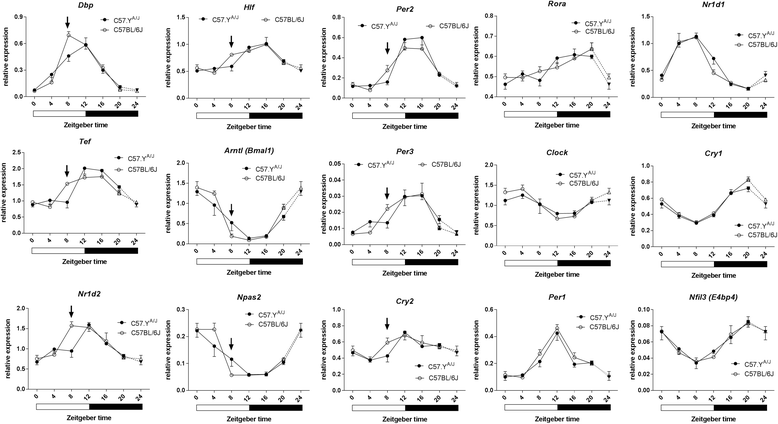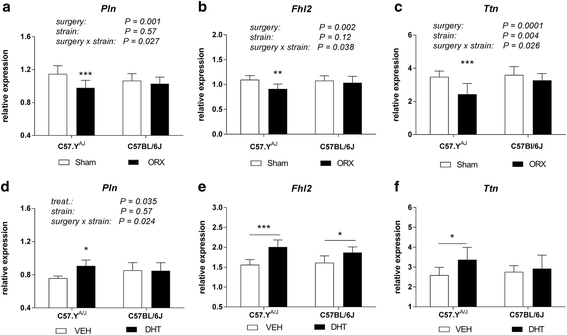Comparisons of chromosome Y-substituted mouse strains reveal that the male-specific chromosome modulates the effects of androgens on cardiac functions
- PMID: 27980711
- PMCID: PMC5143463
- DOI: 10.1186/s13293-016-0116-4
Comparisons of chromosome Y-substituted mouse strains reveal that the male-specific chromosome modulates the effects of androgens on cardiac functions
Abstract
Background: The C57BL/6J.YA/J mouse strain is a chromosome-substituted line where the original male-specific portion of chromosome Y (MSY) from C57BL/6J mice was substituted for that from A/J mice. In hearts from male C57BL/6J.YA/J and C57BL/6J mice, orchidectomy (ORX) affected in a strictly strain-specific fashion the expression a subset of genes showing enrichment for functional categories, including that of circadian rhythms and cardiac contractility. We further tested whether: (1) there were strain-specific differences in cardiac circadian rhythms; (2) strain-dependent differences in the effects of ORX on contractility genes translated into differences in cardiac functions; and (3) differential contractility responses occurred preferentially at times when circadian rhythms also showed strain-specific differences.
Methods: In hearts from the two above strains, we (1) profiled the expression levels of 15 circadian genes at 4-h intervals across a 24 h period; (2) tested the effects of either ORX or androgen replacement on expression of cardiac contractility genes, and that of ORX on myocardial functional reserve; and (3) verified whether the effects of MSY variants on cardiac contractility-related responses showed synchronicity with differences in circadian rhythms.
Results: Among the 15 tested circadian genes, a subset of them were affected by strain (and thus the genetic origin of MSY), which interacted with the amplitude of their peak of maximal expression at 2:00 PM. At that same time-point, ORX decreased (and androgen supplementation increased) the expression of three contractility-related genes, and decreased myocardial relaxation reserve in C57BL/6J.YA/J, but not in C57BL/6J mice. These effects were not detected at 10:00 AM, i.e., at another time-point when circadian genes showed no strain-specific differences.
Conclusions: The results indicate that in mice, androgens have activational effects on cardiac circadian rhythms, contractile gene expression, and myocardial functional reserve. All effects occurred preferentially at the same time of the day, but varied as a function of the genetic origin of MSY. Androgens may therefore be necessary but not sufficient to impart male-specific characteristics to some particular cardiac functions, with genetic material from MSY being one other necessary factor to fully define their range of actions.
Keywords: Androgens; Chromosome Y substituted mouse strains; Circadian genes; Circadian rhythms; Genetic variants; Heart; Male-specific portions of chromosome Y; Myocardial contractile reserve.
Figures




Similar articles
-
Chromosome Y variants from different inbred mouse strains are linked to differences in the morphologic and molecular responses of cardiac cells to postpubertal testosterone.BMC Genomics. 2009 Apr 7;10:150. doi: 10.1186/1471-2164-10-150. BMC Genomics. 2009. PMID: 19351403 Free PMC article.
-
Novel effects of chromosome Y on cardiac regulation, chromatin remodeling, and neonatal programming in male mice.Endocrinology. 2013 Dec;154(12):4746-56. doi: 10.1210/en.2013-1699. Epub 2013 Oct 8. Endocrinology. 2013. PMID: 24105479
-
Quantitative genetics of age-related retinal degeneration: a second F1 intercross between the A/J and C57BL/6 strains.Mol Vis. 2007 Jan 25;13:79-85. Mol Vis. 2007. PMID: 17277741 Free PMC article.
-
A QTL on mouse chromosome 12 for the genetic variance in free-running circadian period between inbred strains of mice.J Circadian Rhythms. 2007 Oct 31;5:7. doi: 10.1186/1740-3391-5-7. J Circadian Rhythms. 2007. PMID: 17974007 Free PMC article.
-
Patterns of Inter-Chromosomal Gene Conversion on the Male-Specific Region of the Human Y Chromosome.Front Genet. 2017 May 3;8:54. doi: 10.3389/fgene.2017.00054. eCollection 2017. Front Genet. 2017. PMID: 28515739 Free PMC article. Review.
Cited by
-
Sexual Dimorphism of the Heart: Genetics, Epigenetics, and Development.Front Cardiovasc Med. 2021 May 26;8:668252. doi: 10.3389/fcvm.2021.668252. eCollection 2021. Front Cardiovasc Med. 2021. PMID: 34124200 Free PMC article. Review.
-
Editorial: Sex differences and cardiovascular therapeutics.Front Cardiovasc Med. 2024 May 20;11:1420293. doi: 10.3389/fcvm.2024.1420293. eCollection 2024. Front Cardiovasc Med. 2024. PMID: 38832315 Free PMC article. No abstract available.
-
Y chromosome is moving out of sex determination shadow.Cell Biosci. 2022 Jan 4;12(1):4. doi: 10.1186/s13578-021-00741-y. Cell Biosci. 2022. PMID: 34983649 Free PMC article. Review.
References
-
- Llamas B, Verdugo RA, Churchill GA, Deschepper CF. Chromosome Y variants from different inbred mouse strains are linked to differences in the morphologic and molecular responses of cardiac cells to postpubertal testosterone. BMC Genomics. 2009;10:150. doi: 10.1186/1471-2164-10-150. - DOI - PMC - PubMed
LinkOut - more resources
Full Text Sources
Other Literature Sources

